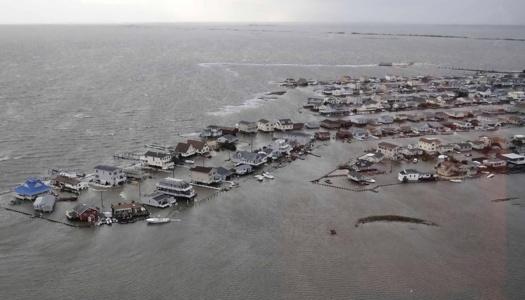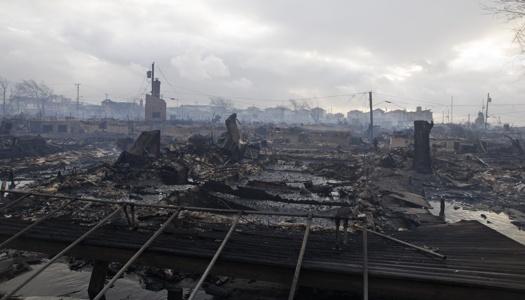Cataclysm

Tuckerton, on the New Jersey Shore, seems to have rejoined the Atlantic Ocean
The storm-caused devastation in the state of New Jersey and in New York City, most of it from sea surges and flooding, seems unprecedented [UPDATE: of course I mean unprecedented for New Jersey and New York.] The worst was the
destruction of about a hundred homes in Breezy Point, Queens, by fire. The photo of it in today’s
New York Post made me think of German and Japanese cities flattened by bombs in World War II:

HORROR SCENE: Ashes and rubble yesterday mark the area where
111 homes were destroyed by fast-spreading fires in Breezy Point,
Queens, while flooding kept firefighters away. It took 12 hours to fight
the blaze, which began Monday night. Many residents had evacuated,
and the remaining ones are believed to have escaped.
Here are some other stories from the
Post:
Utter havoc throughout New Jersey
Sad stories of some of the 35 persons killed in New York City, most of them by falling trees. One young couple were taking a walk in their Brooklyn neighborhood at 7:00 a.m. Tuesday (i.e., after the main storm had passed) when a tree fell on them, killing them. Others were killed in their homes by falling trees. However, one young woman caused her own death. She walked outside her home and was photographing a fallen, sparking power line, and she was electrocuted by it.
Atlantic City under water
Fourteen homes destroyed in Jersey Shore town by natural gas-fueled fire
As bad as it is, it should be understood that the damage could have been far, far worse. The storm was expected to pass through the New Jersey / New York City region at 14 miles per hour. Instead, its speed was twice that, 28 miles per hour. If the storm had moved as slowly as had been expected, it would have lingered over the area and the sea surges would have continued for many hours, causing unimagined catastrophe.
More stories are listed on this page.
- end of initial entry -
LA writes:
I’ve provoked a number of history lessons on hurricanes and other disasters by my use of the word “unprecedented.”
Robert B. writes:
I know the damage you’re looking at is extraordinary by East Coast standards, but in reality, it pales next to the devastation wrought each and every year in Tornado Alley. Those one hundred houses are nothing compared to just one, small tornado touching down in North Minneapolis a few years back:
Every year, the mighty Mississippi and its tributaries flood far more homes than those on the Jersey Shore—which were too close to the ocean in the first place.
I’m not trying to minimize the East Coast’s plight, but simply trying to put it into perspective. In the Midwest, over the decades, houses have been removed from flood ares as a nod to nature’s ability to overcome man’s best efforts to control it. On the East Coast and the West Coast, liberal belief systems contain the hubris that man can control nature and hence the whole belief that we can control global climate. Here, we just accept that nature is what it is and our best efforts can, at best, only mitigate the damage potential. My daughter, who lives near Philadelphia, was in the direct path of the hurricane’s land fall. It was no big deal for her and a romantic adventure of sorts—the loss of power and whatnot. She has experienced much worse here in our own back yard. I sent an email containing a short video of the sky as the grid blew and went down—bright orange flashing lights in the sky.
James P. writes:
Not sure what you mean by “unprecedented”—unprecedented for New York City? [LA replies: Of course that’s what I meant. Do you actually think I meant that this was the worst damage inflicted by a natural disaster in the history of civilization?] Certainly it was nothing compared to the 1900 Galveston Hurricane.
Here are some precedents:
The 1938 New England Hurricane: “The hurricane was estimated to have killed between 682 and 800 people, damaged or destroyed over 57,000 homes, and caused property losses estimated at US$306 million ($4.7 Billion in 2012).”
Hurricane Donna, 1960: “Maximum sustained winds of 105 mph (169 km/h) with gusts of 115 mph (185 km/h) were reported from Long Island and Rhode Island. Storm surge values reached 11 ft (3.4 m) in New York Harbor, which wrecked area piers.”
The Ash Wednesday Storm, 1962: “One of the ten worst storms in the United States in the 20th century, it lingered through five high tides over a three day period, killing 40 people, injuring over 1,000 and causing hundreds of millions in property damage in six states … In New Jersey alone, an estimated 45,000 homes were destroyed or greatly damaged…. on Long Island, communities such as Fire Island were decimated; 100 homes there were destroyed. Wave heights reached 12 m (40 ft) by the shore of New York City.”
Doug H. writes:
You don’t have to go that far away to see similar damage. Here on the Gulf Coast, we experienced similar devastation from hurricanes Opal and Ivan. Fortunately, a lot of us Floridians have learned some hard lessons and now prepare for hurricane season. Since hurricanes are so rare in your part of the country, I imagine people are suffering without supplies. Our church is preparing to head that way with supplies and people. I hope you are not suffering any ill effects.
Doug H. continues:
After looking over a couple more articles, looks like the devastation is going to be worse than anything that has hit Florida, especially due to the fires.
Clark Coleman writes:
Robert B. wrote:
I know the damage you’re looking at is extraordinary by East Coast standards, but in reality, it pales next to the devastation wrought each and every year in Tornado Alley. Those one hundred houses are nothing compared to just one, small tornado touching down in North Minneapolis a few years back.
The link to the Minneapolis tornado story indicates that more than 100 homes were damaged, but “it appeared few houses were totally demolished.” The story indicates one death and 29 injuries. How does that make the New York City damage pale by comparison?
November 1
Robert B. writes:
Clark comments that the tornado that hit North Minneapolis was no big deal—that was my whole point. The little ones are common. They often come as a prelude to thunderstorms or in their aftermath. Unlike a fire where you can leave your home and watch it burn, you cannot run from a tornado—there is no warning, they just happen—right now. I could have been more dramatic and pointed to a town that none of you have ever heard of that was wiped off the map one summer evening—Siren, Wisconsin, which isn’t too far from me. 175 homes were smashed flat. More people don’t die because we are all taught from the earliest ages to get to the basement as fast as possible—and even where to be in the basement—the northwest corner. See this and this.
Then there was Hugo, Minnesota. Poorly built Mac Mansions that went down like pickup sticks. Just imagine sitting around your backyard on Memorial Day barbecuing when baseball (no exaggeration here) sized hail (chunks of ice) start pummeling everything in sight—then next you hear a freight train coming right at you—except there are no train tracks. You run for your basement hoping and praying that if it does hit your house, you will at least live. That was an F3. See this.
In 1998 an F1 (the size of the one that hit Minneapolis) touched down 8 blocks from my house. The houses were all older like mine—80 or so years old and built of brick or stucco. a lot of roofs were collapsed and chimneys knocked down. more than a hundred 60 to 80 foot tall elms and oaks were uprooted and tossed around like pickup sticks. Where was I? In the basement with my children with water pouring through from first floor windows. The rain was being driven by 110 M.P.H. winds, through the closed widows on the north side of the house. The south windows were open to prevent a vacuum imploding the house.
I cannot count all the storms of such that I have either lived through or seen the devastation in the aftermath. I once drove through 60 miles of downed forest after a weekend of “up north” with tornados all around us. The trees were all blown down in the same direction from the straight line winds of 120 + M.P.H. Folk wisdom here dictates that smart people have brick or stucco homes for just this reason—they hold up better in tornados and high winds.
Face it, you people have weeks to prepare for these storms, here, they just happen—often out of a clear blue sky. Except that suddenly the sky turns a greenish yellow and the birds stop chirping and the dogs start looking for shelter—then you know it’s time to hit the cellar. It might be two minutes, it might be 15 minutes, it might be 30 seconds, but it’s coming and you had better move.
Posted by Lawrence Auster at October 31, 2012 01:48 PM | Send

